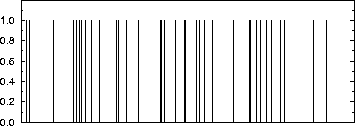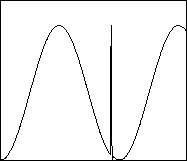
A string of ones and zeros taken from a simulation of radioactive decay

Converting this into a sound file turns out to be really simple. A normal
loudspeaker will respond to a very steep and very high change
in its input signal with the kind of click we want to create.
So all we had to do to create the sound of the
Geiger counter
was converting the string of ones and zeros into a string of minimum and
maximum input value (usually 1..255) of a sound converter and feeding that
into the converter.
Adding clicks to existing soundfiles is just as simple. In the
sonification of the damped harmonic oscillator we added a
click every time the oscillator would pass the x-axis. Whenever the
oscillator passed the x-axis we added the sequence 1,255 which will always
create a click regardless of what the values right before and right after it
are.

 Back to the sound page
Back to the sound page